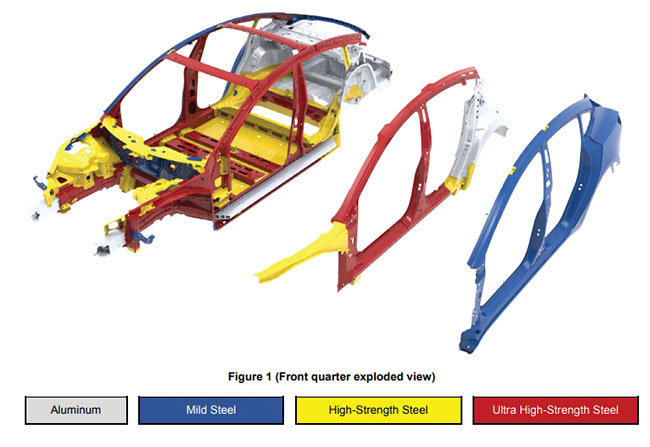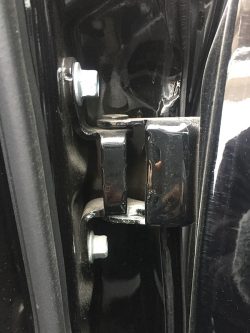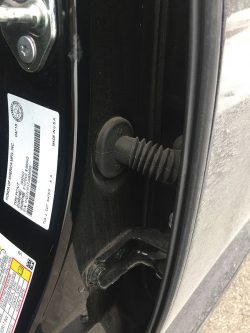
Extrication Tips: Exposing the weakness — Part 1
By Chad Roberts
Features Extrication Auto Extrication Chad Roberts A structural overview of a Tesla Model 3: Note the stronger areas of the steel and its many layers.
A structural overview of a Tesla Model 3: Note the stronger areas of the steel and its many layers. Growing up around the world of sports, I was always taught to play the game fair and work hard. But, to be honest, in sports, the one way to get a leg up on our opponents is to expose and take advantage of their weaknesses. Whether that be an injury, a shortage in players or just a sheer skill match-up, identifying and using this disadvantage is a common way to exceed.
This tactic is no different in the fire service world. It translates, perhaps most directly, with the vehicles at scenes we respond to every day. The constant innovation and technological changes within the automotive industry always challenge us, so we must study and learn from manufacturers in order to truly identify weaknesses that we can use to our advantage. To be fair, our tools are and have been getting better every year, but are we keeping up? Whether your answer to this is yes or no, exposing these areas of new vehicles will go a long way to helping all of us, no matter the punch your packing on your trucks.
So, let’s start this two-part series with the actual research, learning perspective we need to consistently be revisiting. With vehicle technology changing on the daily, we as first responders always seem to be on the sidelines — or at least it may seem that way. However, if we look at it similar-to disciplines such as building construction, as first responders, we can have a great impact on the auto manufacturers and how they identify their hazards and technology. Things such as de-energizing cut loops, air bag identification and high voltage kill fuses are all great examples of how the fire service has been able to lean on and work with the car manufacturers to benefit our service. But those all seem simple and maybe a little too obvious to most of us, so let’s talk about a few other things we can use to expose some of the weaknesses behind our newest vehicles.
First off, get online. The information available to us from the manufacturers has never been more accessible. One of the best examples of this is the site BoronExtrication.com. This website offers first responders’ great access to what the inner workings of newer vehicles are made of from a steel standpoint. With the consistent drive for companies to make safer, lighter and more efficient vehicles, we have seen a strong addition of borons and other synthetic high strength steels that can make our hydraulics seem like they’re 10 years past their prime. Now, I’m not suggesting you try and analyze every make and model or know exactly where some of these high strength materials are. However, by studying a good amount of these, you will quickly get an idea of how these vehicles are generally being constructed and where some of the areas to avoid may be to speed up our extrications and save our tools the embarrassment (“b” post, lower “a” post and upper side frame rail to name a few).
Wiring, wiring and more wiring! It’s everywhere in our newest vehicles. From high voltage to GPS systems, heated seats, power everything; the list goes on and on. While this seems to be a non-issue for us, minus the high voltage orange cables, it can expose a weakness that we can take advantage of, specifically when running wires through the steel of the vehicle. Whenever wiring has to penetrate the steel, whether it be for convenience or to hide it, a hole must be created. These wiring harnesses are something rescuers should key in on but are often overlooked. Keep your cable cutters handy and be ready to cut and remove these harnesses from their steel housing. By doing this we are creating a weak point or purchase point for our cutter tips. By putting one of the cutter blade tips in this hole originally intended for wiring, we are not only creating a purchase point for our tool, it can potentially take advantage of that weaker area in the steel, which will naturally swing the tool towards the weak point (and not towards our patients and rescuers on the inside of the vehicle).
While looking for these wiring harness, keep that field of vision wide open because it will lead us into our next area of weakness we can exploit: door hinges. Along with the stronger steels in the body of newer vehicles, door hinges are becoming increasingly tougher and, a lot of the time, harder to access. With that being said, when removing your wiring harness to create a weak point, have a look at your hinges. How about just removing the bolts holding the door to the frame with an impact gun or maybe just remove the hinge pin itself? These cars were put together merely reversing those steps. What if we can’t see the bolts or pin and the hinge is recessed and difficult to assess? Don’t always rely strictly on your cutters to remove these. While our hydraulics are generally up to the task with these hinges, getting them into a favourable position to cut these recessed hinges will sometimes leave us with nothing more than tool twisting, head scratching or even a broken blade (which can be a frightening event that we don’t need to expose ourselves or our patient to). Instead, let’s attack the weaker areas of our hinge assembles with our spreaders, exposing and easily overcoming the bolts or hinge pins that hold the doors in place.
Simplify and expose the weaknesses. Remember the motto, “defeat our opponents”, when approaching the newest technological hurdles. The information is out there for us. Let’s take advantage of our colder months of the year and use it wisely to educate ourselves and be ready for our newest challenges.
Chad Roberts is a firefighter in Oakville, Ont. He is a member of the Oakville extrication team and competes and trains across North America. Contact Chad at chadroberts12@gmail.com.
Print this page

